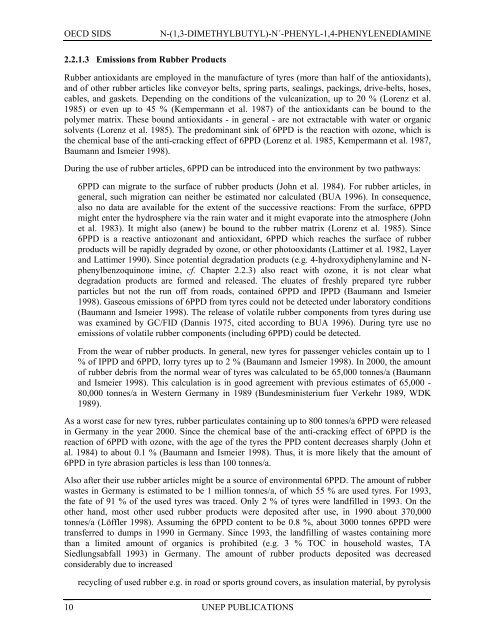N-(1,3-Dimethylbutyl)-N
N-(1,3-Dimethylbutyl)-N
N-(1,3-Dimethylbutyl)-N
Create successful ePaper yourself
Turn your PDF publications into a flip-book with our unique Google optimized e-Paper software.
OECD SIDS<br />
N-(1,3-DIMETHYLBUTYL)-N´-PHENYL-1,4-PHENYLENEDIAMINE<br />
2.2.1.3 Emissions from Rubber Products<br />
Rubber antioxidants are employed in the manufacture of tyres (more than half of the antioxidants),<br />
and of other rubber articles like conveyor belts, spring parts, sealings, packings, drive-belts, hoses,<br />
cables, and gaskets. Depending on the conditions of the vulcanization, up to 20 % (Lorenz et al.<br />
1985) or even up to 45 % (Kempermann et al. 1987) of the antioxidants can be bound to the<br />
polymer matrix. These bound antioxidants - in general - are not extractable with water or organic<br />
solvents (Lorenz et al. 1985). The predominant sink of 6PPD is the reaction with ozone, which is<br />
the chemical base of the anti-cracking effect of 6PPD (Lorenz et al. 1985, Kempermann et al. 1987,<br />
Baumann and Ismeier 1998).<br />
During the use of rubber articles, 6PPD can be introduced into the environment by two pathways:<br />
<br />
6PPD can migrate to the surface of rubber products (John et al. 1984). For rubber articles, in<br />
general, such migration can neither be estimated nor calculated (BUA 1996). In consequence,<br />
also no data are available for the extent of the successive reactions: From the surface, 6PPD<br />
might enter the hydrosphere via the rain water and it might evaporate into the atmosphere (John<br />
et al. 1983). It might also (anew) be bound to the rubber matrix (Lorenz et al. 1985). Since<br />
6PPD is a reactive antiozonant and antioxidant, 6PPD which reaches the surface of rubber<br />
products will be rapidly degraded by ozone, or other photooxidants (Lattimer et al. 1982, Layer<br />
and Lattimer 1990). Since potential degradation products (e.g. 4-hydroxydiphenylamine and N-<br />
phenylbenzoquinone imine, cf. Chapter 2.2.3) also react with ozone, it is not clear what<br />
degradation products are formed and released. The eluates of freshly prepared tyre rubber<br />
particles but not the run off from roads, contained 6PPD and IPPD (Baumann and Ismeier<br />
1998). Gaseous emissions of 6PPD from tyres could not be detected under laboratory conditions<br />
(Baumann and Ismeier 1998). The release of volatile rubber components from tyres during use<br />
was examined by GC/FID (Dannis 1975, cited according to BUA 1996). During tyre use no<br />
emissions of volatile rubber components (including 6PPD) could be detected.<br />
From the wear of rubber products. In general, new tyres for passenger vehicles contain up to 1<br />
% of IPPD and 6PPD, lorry tyres up to 2 % (Baumann and Ismeier 1998). In 2000, the amount<br />
of rubber debris from the normal wear of tyres was calculated to be 65,000 tonnes/a (Baumann<br />
and Ismeier 1998). This calculation is in good agreement with previous estimates of 65,000 -<br />
80,000 tonnes/a in Western Germany in 1989 (Bundesministerium fuer Verkehr 1989, WDK<br />
1989).<br />
As a worst case for new tyres, rubber particulates containing up to 800 tonnes/a 6PPD were released<br />
in Germany in the year 2000. Since the chemical base of the anti-cracking effect of 6PPD is the<br />
reaction of 6PPD with ozone, with the age of the tyres the PPD content decreases sharply (John et<br />
al. 1984) to about 0.1 % (Baumann and Ismeier 1998). Thus, it is more likely that the amount of<br />
6PPD in tyre abrasion particles is less than 100 tonnes/a.<br />
Also after their use rubber articles might be a source of environmental 6PPD. The amount of rubber<br />
wastes in Germany is estimated to be 1 million tonnes/a, of which 55 % are used tyres. For 1993,<br />
the fate of 91 % of the used tyres was traced. Only 2 % of tyres were landfilled in 1993. On the<br />
other hand, most other used rubber products were deposited after use, in 1990 about 370,000<br />
tonnes/a (Löffler 1998). Assuming the 6PPD content to be 0.8 %, about 3000 tonnes 6PPD were<br />
transferred to dumps in 1990 in Germany. Since 1993, the landfilling of wastes containing more<br />
than a limited amount of organics is prohibited (e.g. 3 % TOC in household wastes, TA<br />
Siedlungsabfall 1993) in Germany. The amount of rubber products deposited was decreased<br />
considerably due to increased<br />
<br />
10<br />
recycling of used rubber e.g. in road or sports ground covers, as insulation material, by pyrolysis<br />
UNEP PUBLICATIONS
















